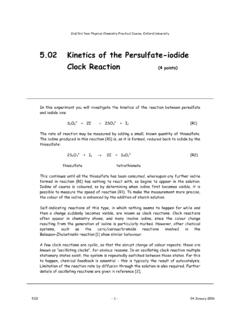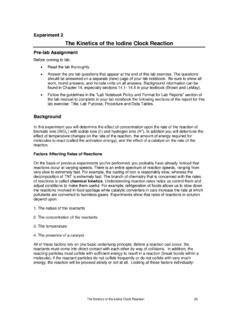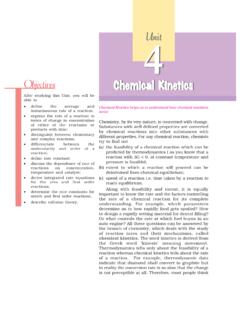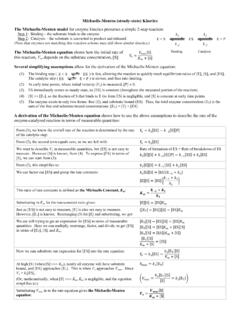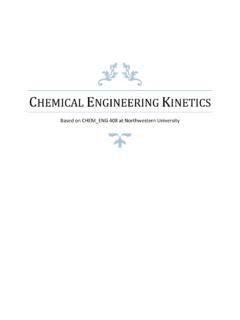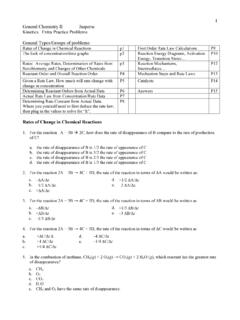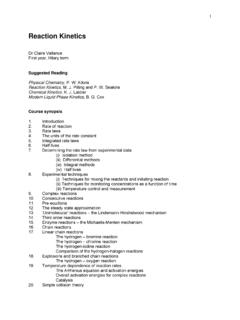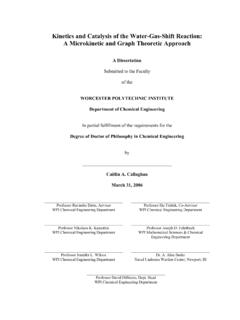Transcription of A Sample Lab Report The Iodine Clock Reaction Introduction
1 A Sample Lab Report The Iodine Clock Reaction Introduction : The factors that affect the rate of a chemical Reaction are important to understand due to the importance of many such reactions to our health, well-being and comfort. It would be advantageous to slow down some of these reactions such as food spoilage and rust formations, while in the cases of reactions such as the Tums-stomach acid Reaction and the conversion of organic matter to fossil fuels, it would be beneficial to them speed up. The rate of a Reaction is governed by the collision theory. In order for a Reaction to occur, there must be a collision between reactant molecules. This collision must have enough energy to break and form the appropriate bonds as well as have the correct orientation when colliding.(1) When all of these things happen, a chemical Reaction has occurred.
2 If we can increase the amount of these favourable collisions, then we increase the rate of the Reaction .(1) One of the factors that affects Reaction rate is reactant concentration. The more reactant molecules in a given area, the greater the number of collisions possible.(1) Whenever we have a larger number of collisions possible, there is a probability of having a favourable collision increases. The opposite is true if we have a lower concentration of reactant molecules. Another factor that affects the rate of Reaction is temperature. In this case, there are not more reactant molecules to collide. Temperature is proportional to the average kinetic energy, which is the energy associated with motion.(2) All reactions have what is called the Minimum Threshold Energy. This is the amount of kinetic energy it takes for reactant bonds to break, re-arrange and form the bonds necessary to make products.
3 (1) This energy is equivalent to the activation energy of the Reaction . When we increase the temperature of a Reaction , the average kinetic energy of the reactants increase.(1) This change results in two things. First, the molecules show an increase in motion within the confines of the same area causing an increase in the amount of collisions. Second, more molecules now have an energy equal to the Minimum Threshold Energy and can now form products. More collisions, more energy, and a greater probability of favourable collisions leads to an increase in Reaction rate. Again, the opposite is true if we decrease the temperature. Purpose/Objective: The purpose of this lab is to observe the effect of temperature and concentration on the rate of a chemical Reaction . (OR The objective of this lab is to observe the effect of temperature and concentration on the rate of a chemical Reaction .)
4 Procedure: Please refer to Heath Chemistry: Laboratory Experiments (Canadian Edition), DiSpezio, Michael, A., et al, 1987, Heath Canada, Ltd. pg. 197-203 Data and Observations: Data Table 1: Effect of Concentration Volume of KIO3 (mL) Time for Reaction (s) 3 65 257 Average Time for Reaction (s) 2 4 8 16 32 64 128 256 512 Data Table 2: Effect of Temperature Temperature ( C) Time for Reaction (s) 63 Average Time for Reaction (s) 64 32 16 8 4 2 Observation Table 1: Observations of Chemical Reaction Between Solution A and B Solution A clear solution Solution B cloudy whitish solution Observations after mixing produced a strong blue colour each time Calculations: Sample Calculation #1: Calculation of Molarity of KIO3 (volume of KIO3 as 9 mL) MdVd = McVc Md ( mL) = ( )( ) Md = ( )( ) M(KIO3) = Sample Calculation #2: Calculation of Reaction Rate (at temperature of 15 C) Rate = [KIO3] t Rate = Rate = x 10-4 M/s = Results: Results Table 1: Reaction Rate As Dependent Upon Concentration (see Graph 1) [KIO3] M Rate of Reaction (M/s) x 10-3 Average Rate (M/s) x 10-3 Results Table 2.
5 Reaction Rate as Dependent Upon Temperature (see Graph 2) Temperature ( C) 5 10 15 20 25 35 Rate of Reaction (M/s) x 10-3 Average Rate of Reaction (M/s) x 10-3 Discussion: According to the data the purpose was achieved. In the study of the effect of concentration on the rate of a Reaction , it was found that when increasing the concentration of a reactant, the rate also increases (see results table 1). This was seen in both the class average data as well as individual data. As demonstrated by plotting Reaction rate against concentration of KIO3, this increasing relationship is exponential (see graph 1). This result is expected when taking the collision theory into consideration. According to the collision theory, in order for reactants to form products there must be successful collisions between reactant molecules.
6 Successful collisions are those that have enough energy to break and reform bonds and have the correct collision orientation or geometry. The correct orientation is necessary to form the activation complex, a short-lived transition between reactants and products. When there are a greater number of reactant molecules available to react, there is a greater chance of a successful collision due to probability arguments. In the case of this study, the more KIO3 that was present per unit volume, the greater opportunity there was for a successful collision to happen. There were more successful collisions as evidenced by more product being formed in a shorter period of time (colour change faster, see data and observation table 1). The graph of Reaction rate vs. concentration confirms this increase-increase relationship (see graph 1).
7 The graphical relationship between Reaction rate and temperature was also demonstrated to be exponential and increasing (see graph 2). This relationship is also demonstrated by the results used to generate the graph (see results table 2). The results produced in the study of temperature and Reaction rate are as expected when taking the collision theory into account. As mentioned previously, reactants can only form products if successful collisions have taken place. This means that the collisions must have enough energy and correct orientation.(1) When temperature is increased, the average kinetic energy of the molecules is also increased since this is the definition of temperature. It is now more likely that any given molecule will have enough energy to surpass the activation energy for the Reaction . Because more molecules will have enough energy to get to products, more products will be formed in a given amount of time thereby increasing the Reaction rate.
8 There were many possible sources of errors in the lab procedure. Reaction times when attempting to record the time it took for colour to change are extremely variable. Since the procedure included the use of data from other lab groups, this would have a large affect on the results. Although the use of averages minimizes variability in the data, the calculations of Reaction rate and the plotting of the graph may be in error. Since the time it takes for the colour change to first appear is used to calculate the rate values, this error will have a direct impact on the accuracy of the rate values. It is possible that the solutions that were provided were not exactly the same molarity. If the same solution was not used each time, the Reaction times may be faster or slower than expected. Concentration, as was demonstrated in this lab, will affect the Reaction rate calculated.
9 Also, the solutions may not be well mixed thereby changing their affective concentrations. Again, since the concentration values were used in order to calculate rate, this error will affect the results substantially. In the calculation of rate, the given molarity is used in the calculation. If the actual concentration was lower than the given one, the Reaction time would be slower than expected. Conversely, if the actual concentration was higher than the one given, the Reaction time would be larger than it should be. For the temperature portion of this lab, different lab groups tested different temperatures. Whenever there are different people involved in one set of data, there will be variability in measurement techniques. These measurement techniques, whether they are time, temperature, or colour change, all have an influence on the resulting Reaction rate value.
10 Variablilities in any of these measurements will cause variabilities in Reaction rates. Any inaccuracies in the measurements will bring about inaccuracies in the Reaction rates. It would be, therefore, difficult to be confident about the Reaction rates calculated for the lab. Large inaccuracies could make it difficult to see the trends necessary for the understanding of this experiment. Conclusion: According to the data, the purpose was reached. The rate of a Reaction is seen to increase when temperature or concentration are increased considering experimental error. Literature Cited: 1. Hebden, James A., Chemistry 12: A Workbook For Students, 1997, Hebden Home Publishing: Kamloops, pg. 5-22 2. Serway, Raymond A. and Jerry S. Faughn, College Physics, 1985, Saunders College Publishing: Philadelphia, pg 244
